
Maytag MVWB880BW
About Maytag
Maytag is a brand of home appliances, including washing machines, dryers, dishwashers, refrigerators, and ranges. The brand is known for its durable and reliable products, with many models featuring a 10-year limited warranty on certain parts.
Maytag is a subsidiary of Whirlpool Corporation, one of the largest appliance manufacturers in the world. Maytag appliances are available for purchase through a variety of retailers, both online and in-store.
WASHER SAFETY

SAFETY INSTRUCTIONS

Cleaning with Less Water

The most striking difference in your new washer is the low-water wash plate wash system. The washer automatically adjusts the water level to the load size—no water level selector is needed.

Load garments in loose heaps evenly around the wash plate. Do not load garments directly over the center of the wash plate; when loaded, the center of the wash plate should be visible.

As the washer dampens and moves the load, the level of the garments will settle in the basket. This is normal and does not indicate that more garments should be added.
IMPORTANT:
You will not see a washer basket full of water as with your past agitator-style washer. It is normal for some of the load to be above the water line.
INTELLIFILL Water Level Control.
Once you start the cycle, the lid will lock, and the washer will begin the sensing process to determine the correct water level for the load. You will find a step-by-step description in the “Cycle Status Lights” section. You will hear the motor turn the basket in short pulses to thoroughly wet the load. This low-water wash method uses less water and energy compared to a traditional agitator-style washer.
Auto Temperature Control
Auto Temperature Control (ATC) regulates incoming hot and cold water, blending the temperatures for optimal and consistent cleaning. The ATC is automatically turned on when a cycle is selected.
Choosing the Right Detergent
Use only High-Efficiency detergents. The package will be marked “HE” or “High Efficiency.” Low-water washing creates excessive sud sing with a regular non-HE detergent. Using regular detergent will likely result in longer cycle times and reduced rinsing performance. It may also result in component failures and noticeable mold or mildew. HE detergents are made to produce the right amount of suds for the best performance. Follow the manufacturer’s instructions to determine the amount of detergent to use.
Concentrated Cleaning
Low-water cleaning means concentrated cleaning. Rather than diluting detergent as done in an agitator-style washer, this washer delivers the detergent directly to the soil.
Normal Sounds You Can Expect
At different stages of the wash cycle, you may hear sounds and noises that are different from those of your previous washer. For example, you may hear a clicking and hum at the beginning of the cycle, as the lid lock goes through a self-test. There will be different kinds of humming and whirring sounds as the wash plate moves the load. And sometimes, you may hear nothing at all, as the washer determines the correct water level for your load or allows time for clothes to soak.
CONTROL PANEL AND FEATURES

- ESTIMATED TIME REMAINING DISPLAY
The Estimated Time Remaining display shows the time required for the cycle to complete. Factors such as load size and water pressure may affect the time shown in the display. Tightly packed or unbalanced loads or excessive suds may cause the washer to adjust the cycle time, as well. - POWER/CANCEL BUTTON
Press to turn the washer ON or OFF. - WASH CYCLE KNOB
Use the Wash Cycle knob to select available cycles on your washer. Turn the knob to select a cycle for your laundry load. See “Cycle Guide” for detailed descriptions of cycles. - START/PAUSE BUTTON
Press to start the selected cycle. Be sure all desired Modifiers and Options have been selected. Press START/PAUSE once to unlock the lid and add a garment. Press START/PAUSE again to complete the cycle from where it was stopped. The lid must be closed for the washer to start. - CYCLE MODIFIERS
Modifiers allow you to further customize your cycles and save energy. Not all cycles, options, and modifiers are available on all models.
- WASH TEMP
Select a water temperature based on the type of load you are washing. Use the warmest wash water suitable for fabrics. Follow garment label instructions. All cycles use cold rinses. Cold rinses may help with wrinkling and save energy.
NOTE: In wash water temperatures colder than 60°F (15.6°C), detergents do not dissolve well. Soils may be difficult to remove. - SPIN SPEED
This washer automatically selects the spin speed based on the cycle selected. The preset speeds can change Not all spin speeds are available with all cycles.- Faster spin speeds mean shorter dry times but may increase wrinkling in your load.
- Slower spin speeds mean less wrinkling but will leave your load damper.
- SOIL LEVEL
Soil Level (wash time) is preset for each wash cycle. As you press Soil Level, the cycle time (minutes) will increase or decrease in the Estimated Time Remaining display and a different wash time will appear.
For most loads, use the Soil Level that is preset with the cycle you have chosen. For heavily soiled and sturdy fabrics, press SOIL LEVEL to select more wash time, if needed. For lightly soiled and delicate fabrics, press SOIL LEVEL to select less wash time, if needed. Lower Soil Level settings will help reduce tangling and wrinkling. - CYCLE OPTIONS
When you select a cycle, its default options will light up. Not all cycles, options, and modifiers are available on all models.- WATER SAVE SPRAY RINSE
Use this option to save water by using a spray rinse instead of a deep water rinse. This option is the default setting on some cycles, and selectable on other cycles. When using fabric softener, always select the FABRIC SOFTENER button, or select EXTRA RINSE; both of these options will dispense fabric softener in a deep rinse. - EXTRA RINSE
This option can be used to automatically add a second rinse to most cycles. - FABRIC SOFTENER
This option must be selected if using fabric softener during a cycle. It ensures that fabric softener is added at the correct time in the rinse for even distribution. - CYCLE SIGNAL
Use this option to adjust the volume of the signal that sounds at end of the cycle. You may select Hi, Low, or Off (no indicator lit). A louder signal is helpful in removing items as soon as the cycle is complete
You may also add or remove options for each cycle. Not all options can be used with all cycles, and some are preset to work with certain cycles. - To turn Button Sounds either Off or On:
Button Sounds can be turned off or on by holding down the Cycle Signal button for 5 seconds. The washer will make a single short beep/tone when complete. This function can be completed at any time during the washer’s operation, but not in STANDBY. - When the Button Sounds function is set to Off:
- Invalid key selection tones (3 short beeps/tones) will still remain active but will sound at the “SOFT” volume level.
- All Valid key selection tones (1 short beep/tone) are disabled including Power/Cancel and End of Cycle signal, as well as the chime that is produced when turning the cycle knob past NORMAL.
NOTE: The chosen setting will remain in effect through a power loss.
- WATER SAVE SPRAY RINSE
- LID LOCK INDICATOR
 This light indicates that the lid is locked and cannot be opened. If you need to open the lid, press START/PAUSE. The lid will unlock once the washer movement has stopped. This may take several minutes if the load was spinning at high speed. Press START/PAUSE again to restart the cycle.
This light indicates that the lid is locked and cannot be opened. If you need to open the lid, press START/PAUSE. The lid will unlock once the washer movement has stopped. This may take several minutes if the load was spinning at high speed. Press START/PAUSE again to restart the cycle. - CYCLE STATUS LIGHT INDICATORS
The Cycle Status Lights show the progress of a cycle. At each stage of the process, you may notice sounds or pauses that are different from traditional washers.- FILL
When the Start/Pause button is pressed, the washer will add a small amount of water to the load, then pause for a few seconds. The lid will then lock and the washer will continue to fill. - WASH
You will hear the motor and wash plate moving the load. It is normal for some of the load to be above the water line. Low-water cleaning means concentrated cleaning. Rather than diluting detergent as done in an agitator-style washer, this washer delivers the detergent directly to the soil. The motor sounds may change at different stages in the cycle. The wash time is determined by the selected Soil Level. - RINSE
You will hear sounds similar to the wash cycle as the washer rinses and moves the load. You may hear the motor turning on briefly to move the basket while filling. Fabric softener will be added if the Fabric Softener option was selected. Some cycles use spray rinsing. - SPIN
The washer spins the load at increasing speeds for proper water removal, based on the selected cycle and spin speed. - DONE
Once the cycle is complete, this light will come on. Remove the load promptly for best results. - ADD A GARMENT
You may place additional clothing in the wash when the Add a Garment indicator is lit without sacrificing wash performance. Press START/PAUSE once. The Lid Lock light will turn off. Open the washer lid, add garments, and close the lid. Press START/PAUSE to restart. - CLEAN WASHER REMINDER
The Clean Washer Reminder indicator lights after 30 wash cycles without a clean washer cycle. See the “Washer Care” section to run the clean washer cycle, or you can press the REMINDER RESET button to manually reset the clean washer cycle counter.
- FILL
DISPENSERS
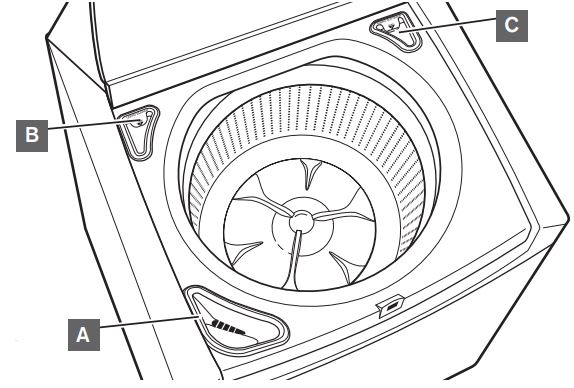
- A: High-Efficiency “HE” detergent dispenser
Add liquid or powdered HE detergent product to this dispenser for your main wash cycle. - B: Liquid chlorine bleach dispenser
This dispenser holds up to 3/4 cup (180 mL) of liquid chlorine bleach. The breach will be automatically diluted and dispensed at the optimum time during the wash cycle. This dispenser cannot dilute powdered bleach. Use the liquid chlorine bleach dispenser for liquid chlorine bleach or color-safe bleach. - C: Liquid fabric softener dispenser
Pour measured liquid fabric softener into the liquid fabric softener dispenser, if desired. It will dispense automatically at the optimum time when the Fabric Softener option is selected.- Use only liquid fabric softener in this dispenser.
- Do not overfill. Do not dilute. The dispenser holds 3 oz (94 mL), or a capful of fabric softener.
- Fabric softener is dispensed in a deep rinse when the Fabric Softener option is selected. If Extra Rinse is selected, the fabric softener will be dispensed during the final rinse.
- Do not use fabric softener dispensing balls in this washer. Dispensing balls will not operate correctly with this washer.
- Do not spill or drip any fabric softener onto the clothes.
- At the end of the cycle, a small amount of water may be left in the dispenser. This is normal.
CYCLE GUIDE
Settings and options shown in bold are the default settings for that cycle. For the best fabric care, choose the cycle that best fits the load being washed. Not all cycles and options are available on all models


* Wash temperatures vary according to the chosen cycle setting. All cycle settings use a cold rinse temperature.
** Not all models default to the same Soil Level setting. Some models will default to Medium on this cycle.
*** Not all models default to the same Soil Level setting. Some models will default to Heavy on this cycle.
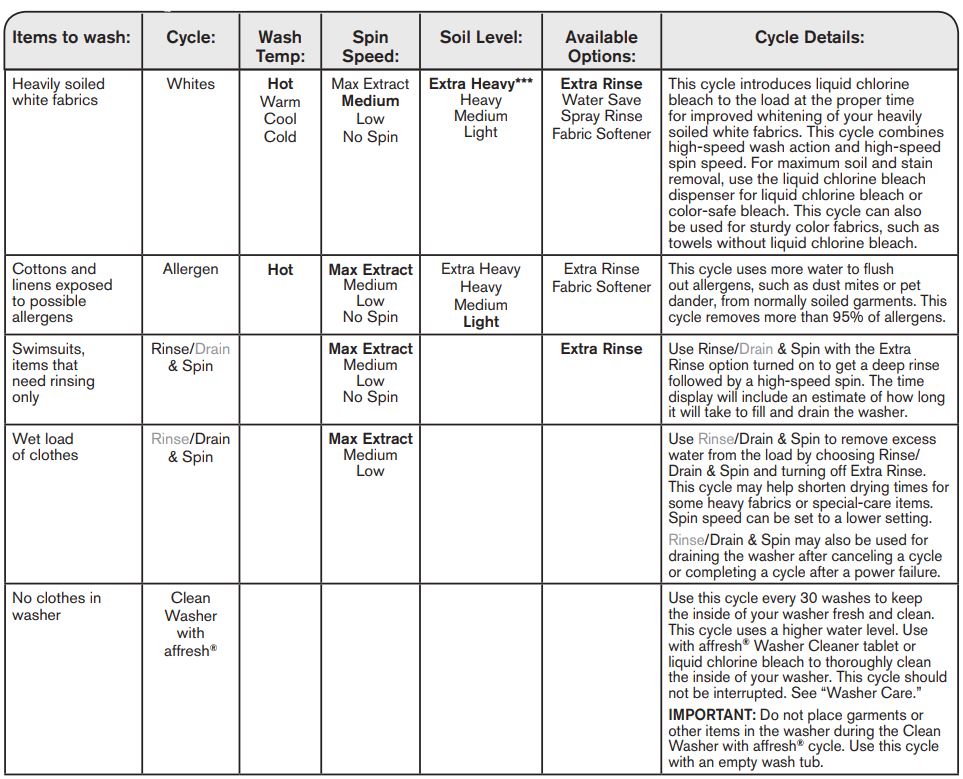
* Wash temperatures vary according to the chosen cycle setting. All cycle settings use a cold rinse temperature.
*** Not all models default to the same Soil Level setting. Some models will default to Heavy on this cycle.
USING YOUR WASHER

- Sort and prepare your laundry

- Empty pockets. Loose change, buttons, or any small object can pass under the wash plate and become trapped, causing unexpected sounds.
- Sort garments by recommended cycle, water temperature, and colorfastness.
- Separate heavily soiled garments from lightly soiled.
- Separate delicate garments from sturdy fabrics.
- Do not dry garments if stains remain after washing; heat can set stains into fabric.
- Treat stains promptly.
- Close zippers, fasten hooks, tie strings, and sashes. Remove non-washable trim and ornaments.
- Mend rips and tears to avoid further damage to garments during washing.
Helpful Tips:- When washing water-proof or water-resistant items, load evenly. See “Cycle Guide” for tips and more information on using the Bulky cycle.
- Use mesh bags to help avoid tangling when washing delicate or small items.
- Turn knits inside out to avoid pilling. Separate lint-takers from lintgivers. Synthetics, knits, and corduroy fabrics will pick up lint from towels, rugs, and chenille fabrics.
NOTE: Always read and follow fabric care labels instructions to avoid damage to your garments.
- Add laundry products
 Add a measured amount of detergent or a single-dose laundry packet into the basket. If using Oxi-type boosters, color-safe bleach, or fabric softener crystals, add to the bottom of the washer basket before adding clothes.
Add a measured amount of detergent or a single-dose laundry packet into the basket. If using Oxi-type boosters, color-safe bleach, or fabric softener crystals, add to the bottom of the washer basket before adding clothes.
NOTE: Follow the manufacturer’s instructions to determine the number of laundry products to use. - Load laundry into the washer

Load garments in loose heaps evenly around the wash plate. Do not load garments directly over the center of the wash plate; when loaded, the center of the wash plate should be visible. Try mixing different-sized garments to reduce tangling.
IMPORTANT: Garments need to move freely for the best cleaning and to reduce wrinkling and tangling.
NOTE: Do not add single-dose laundry packets, Oxi-type boosters, or fabric softener crystals to dispensers. They will not dispense correctly - Add HE detergent to the dispenser
 Add a measured amount of HE detergent to the detergent dispenser.
Add a measured amount of HE detergent to the detergent dispenser.
IMPORTANT: Use only High-Efficiency detergents. The package w be marked “HE” or “High Efficiency.” Low-water washing creates excessive sud sing with a regular non-HE detergent. Using regular detergent will likely result in longer cycle times and reduced rinsing performance. It may also result in component failures and noticeable mold or mildew. HE detergents are made to produce the right amount of suds for the best performance. Follow the manufacturer’s instructions to determine the amount of detergent to use.
HELPFUL TIP: See “Washer Maintenance” for information on recommended method of cleaning washer dispensers. - Add liquid chlorine bleach to the dispenser
 Do not overfill, dilute, or use more than 3/4 cup (180 mL). For maximum soil and stain removal, you may use the liquid chlorine bleach dispenser for liquid chlorine bleach or color-safe bleach.
Do not overfill, dilute, or use more than 3/4 cup (180 mL). For maximum soil and stain removal, you may use the liquid chlorine bleach dispenser for liquid chlorine bleach or color-safe bleach. - Add liquid fabric softener to the dispenser
 Pour a measured amount of liquid fabric softener into the dispenser; always follow the manufacturer’s directions for the correct amount of fabric softener based on your load size. Then select the Fabric Softener option.
Pour a measured amount of liquid fabric softener into the dispenser; always follow the manufacturer’s directions for the correct amount of fabric softener based on your load size. Then select the Fabric Softener option.
IMPORTANT: The fabric Softener option must be selected to ensure proper distribution at the correct time in the cycle. Do not overfill or dilute. The overfilling dispenser will cause the fabric softener to immediately dispense into the washer.
If the Extra Rinse option is selected, fabric softener will be dispensed in the last rinse.
NOTE: Do not use liquid fabric softener dispenser balls in this washer. They will not dispense correctly. - Press POWER/CANCEL to turn on the washer

- Select cycle
 Turn the cycle knob to choose your wash cycle. Estimated Time Remaining will light up with a cycle time. You may notice time adjusting during the cycle. This is normal.
Turn the cycle knob to choose your wash cycle. Estimated Time Remaining will light up with a cycle time. You may notice time adjusting during the cycle. This is normal.
- Select cycle modifiers
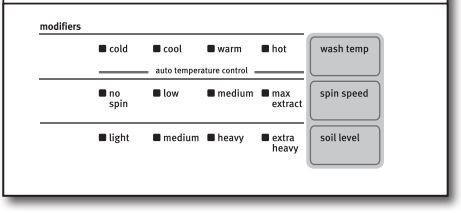
Once you select a cycle, the default settings for that cycle will be lit. Press the Modifier buttons to change the Wash Temp, Spin Speed, and Soil Level if desired. Not all settings are available with all cycles.
NOTE: Always read and follow fabric care label instructions to avoid damage to your garments.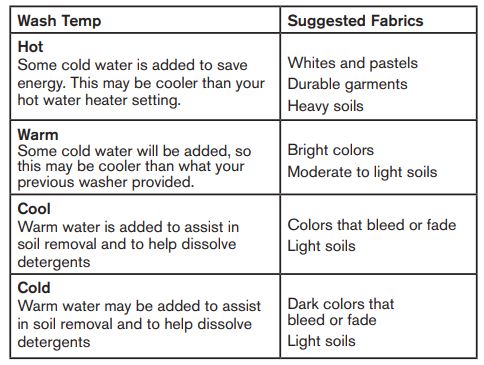
- Select cycle options

Select any other cycle options you may wish to add, if not previously set. Some cycles will automatically add certain options such as Extra Rinse. These may be turned off if desired.
NOTE: Not all options are available with all cycles. - Press START/PAUSE to begin the wash cycle

Press the START/PAUSE button to start the wash cycle. When the cycle has finished, the end-of-cycle signal will sound (if set). Promptly remove garments when the cycle is done to avoid odor, and reduce wrinkling, and rusting of metal hooks, zippers, and snaps. If the lid is left open for more than 10 minutes, the water will pump out.
WASHER MAINTENANCE
WATER INLET HOSES
Replace inlet hoses after 5 years of use to reduce the risk of hose failure. Periodically inspect and replace inlet hoses if bulges, kinks, cuts, wear, or leaks are found. When replacing your inlet hoses, mark the date of replacement on the label with a permanent marker. NOTE: This washer does not include inlet hoses. See the Installation Instructions for more information.
WASHER CARE
Recommendations to Help Keep Your Washer Clean and Performing at its Best
- Always use High Efficiency (HE) detergents and follow the HE detergent manufacturer’s instructions regarding the amount of HE detergent to use. Never use more than the recommended amount because that may increase the rate at which detergent and soil residue accumulate inside your washer, which in turn may result in undesirable odor.
- Use warm and hot wash water settings sometimes (not exclusively cold water washes), because they do a better job of controlling the rate at which soils and detergent accumulate.
- Always leave the washer lid open between uses to help dry out the washer and prevent the buildup of odor-causing residue.
Cleaning Your Top Loading Washer
Read these instructions completely before beginning the routine cleaning processes recommended below. This Washer Maintenance Procedure should be performed, at a minimum, once per month or every 30 wash cycles, whichever occurs sooner, to control the rate at which soils and detergent may otherwise accumulate in your washer.
Cleaning the Inside of the Washer
To keep your washer odor-free, follow the usage instructions provided above, and use this recommended monthly cleaning procedure:
Clean Washer Cycle
This washer has a special cycle that uses higher water volumes in combination with affresh ® Washer Cleaner or liquid chlorine bleach to clean the inside of the washer.
Begin procedure
- affresh ® Washer Cleaner Cycle Procedure (Recommended for Best Performance):
- a. Open the washer lid and remove any clothing or items.
- b. Place an affresh ® Washer Cleaner tablet in the bottom of the washer basket.
- c. Do not place an affresh ® Washer Cleaner tablet in the detergent dispenser.
- d. Do not add any detergent or other chemicals to the washer when following this procedure.
- e. Close the washer lid.
- f. Select the CLEAN WASHER cycle.
- g. Press the START/PAUSE button to begin the cycle. The Clean Washer Cycle Operation is described below.
- NOTE: For best results, do not interrupt the cycle. If the cycle must be interrupted, press POWER/CANCEL. (For models with no Power/Cancel button, press and hold START/ PAUSE for three seconds). After the Clean Washer cycle has stopped, run a Rinse/Drain & Spin cycle to rinse the cleaner from the washer.
- Chlorine Bleach Procedure (Alternative):
- a. Open the washer lid and remove any clothing or items.
- b. Add 1 cup (236 mL) of liquid chlorine bleach to the bleach compartment.
NOTE: Use of more liquid chlorine bleach than is recommended above could cause washer damage over time. - c. Close the washer lid.
- d. Do not add any detergent or other chemicals to the washer when following this procedure.
- e. Select the CLEAN WASHER cycle.
- f. Press the START/PAUSE button to begin the cycle. The Clean Washer Cycle Operation is described below.
NOTE: For best results, do not interrupt the cycle. If the cycle must be interrupted, press POWER/CANCEL. (For models with no Power/Cancel button, press and hold START/ PAUSE for three seconds). After the Clean Washer cycle has stopped, run a Rinse/Drain & Spin cycle to rinse the cleaner from the washer.
Description of Clean Washer Cycle Operation:
- This cycle will fill to a water level higher than in normal wash cycles to provide rinsing at a level above the water line for the normal wash cycle.
- During this cycle, there will be some agitation and spinning to increase the removal of soil.
After this cycle is complete, leave the lid open to allow for better ventilation and drying of the washer interior.
Cleaning the Dispensers
After a period of using your washer, you may find some residue buildup in the washer’s dispensers. To remove residue from the dispensers, wipe them with a damp cloth and towel dry. Do not attempt to remove the dispensers or trim for cleaning. The dispensers and trim are not removable. If your model has a dispenser drawer, however, remove the drawer and clean it before or after you run the Clean Washer cycle. Use an all-purpose surface cleaner, if needed.
Cleaning the Outside of the Washer
Use a soft, damp cloth or sponge to wipe away any spills. Use only mild soaps or cleaners when cleaning external washer surfaces.
IMPORTANT: To avoid damaging the washer’s finish, do not use abrasive products.
NON-USE AND VACATION CARE
Operate your washer only when you are home. If moving, or not using your washer for a period of time, follow these steps:
- Unplug or disconnect the power to the washer.
- Turn off the water supply to the washer, to avoid flooding due to water pressure surge.
WINTER STORAGE CARE
IMPORTANT: To avoid damage, install and store the washer where it will not freeze. Because some water may stay in hoses, freezing can damage the washer. If storing or moving during freezing weather, winterize your washer.
To winterize the washer:
- Shut off both water faucets; disconnect and drain water inlet hoses.
- Put 1 qt. (1 L) of R.V.-type antifreeze in the basket and run the washer on the RINSE/DRAIN & SPIN cycle for about 30 seconds to mix the antifreeze and remaining water.
- Unplug the washer or disconnect the power.
TRANSPORTING YOUR WASHER
- Shut off both water faucets. Disconnect and drain water inlet hoses.
- If the washer will be moved during freezing weather, follow WINTER STORAGE CARE directions before moving.
- Disconnect the drain from the drain system.
- Unplug the power cord.
- Place inlet hoses inside the washer basket.
- Drape the power cord and drain hose over the console and secure them with masking tape.
- Place the foam packing ring from the original shipping materials back inside the washer. If you do not have a packing ring, place heavy blankets or towels into the basket opening. Close the lid and place tape over the lid and down the front of the washer. Keep the lid taped until the washer is placed in a new location.
REINSTALLING/USING THE WASHER AGAIN
To reinstall the washer after non-use, vacation, winter storage or moving:
- Refer to Installation Instructions to locate, level, and connect the washer.
- Before using it again, run the washer through the following recommended procedure:
To use the washer again:
- Flush water pipes and hoses. Reconnect water inlet hoses. Turn on both water faucets.
- Plug in the washer or reconnect the power.
- Run the washer through a BULKY cycle to clean the washer and remove antifreeze, if used. Use only HE High-Efficiency detergent. Use half the manufacturer’s recommended amount for a medium-size load.
TROUBLESHOOTING
First, try the solutions suggested here or visit our website to possibly avoid the cost of a service call. In U.S.A. www.maytag.com/product_help – In Canada www.maytag.ca
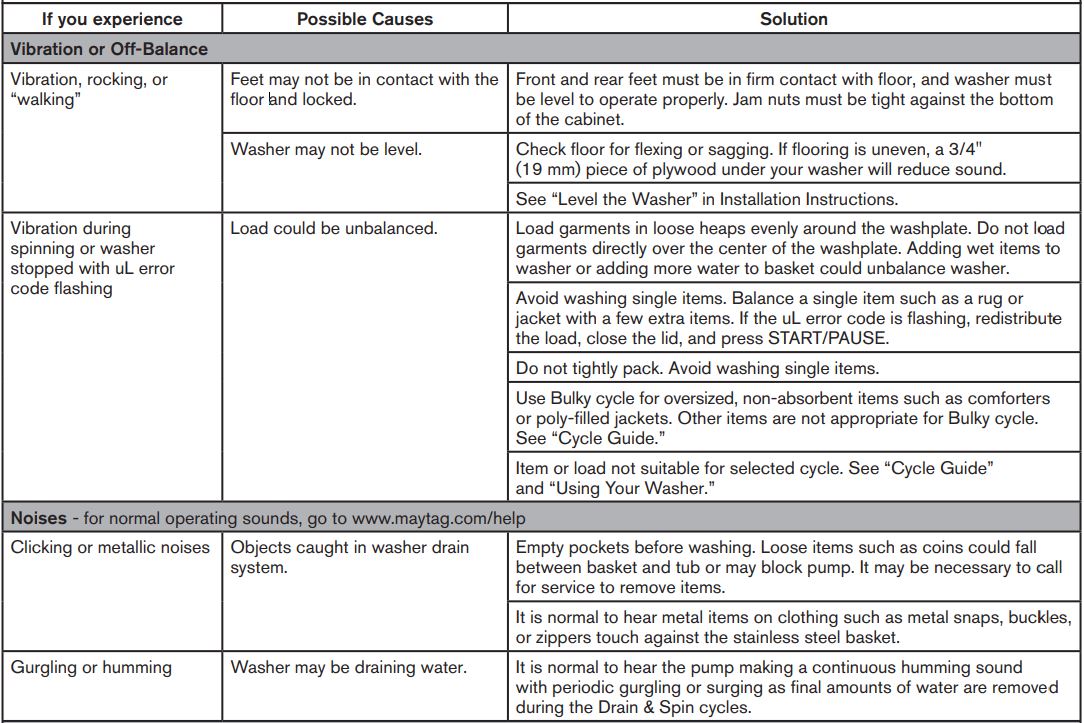

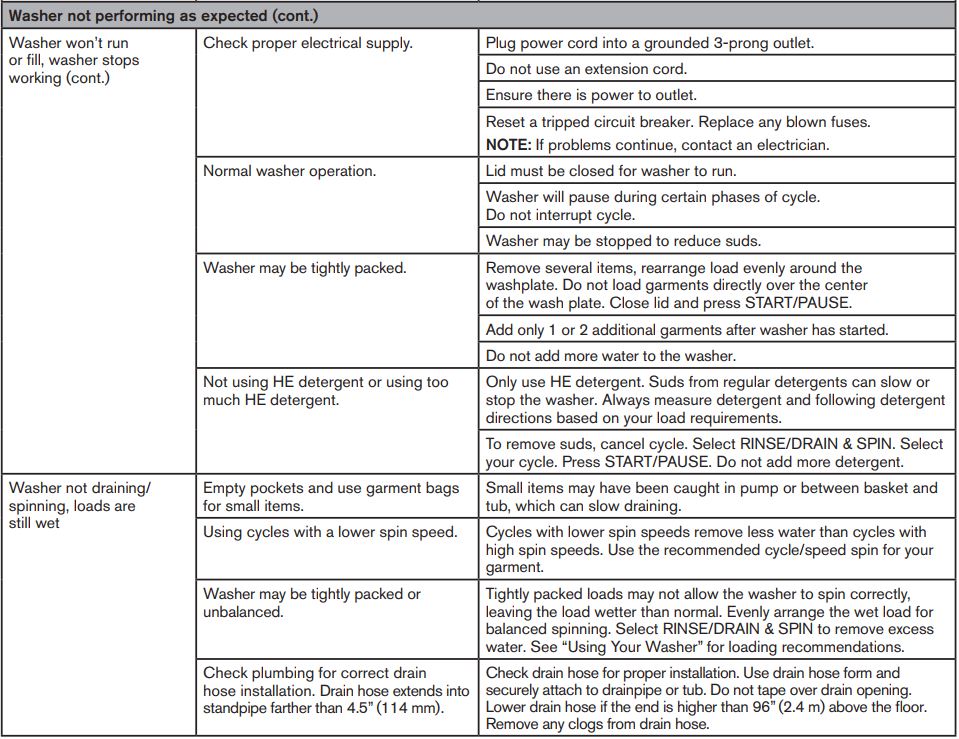
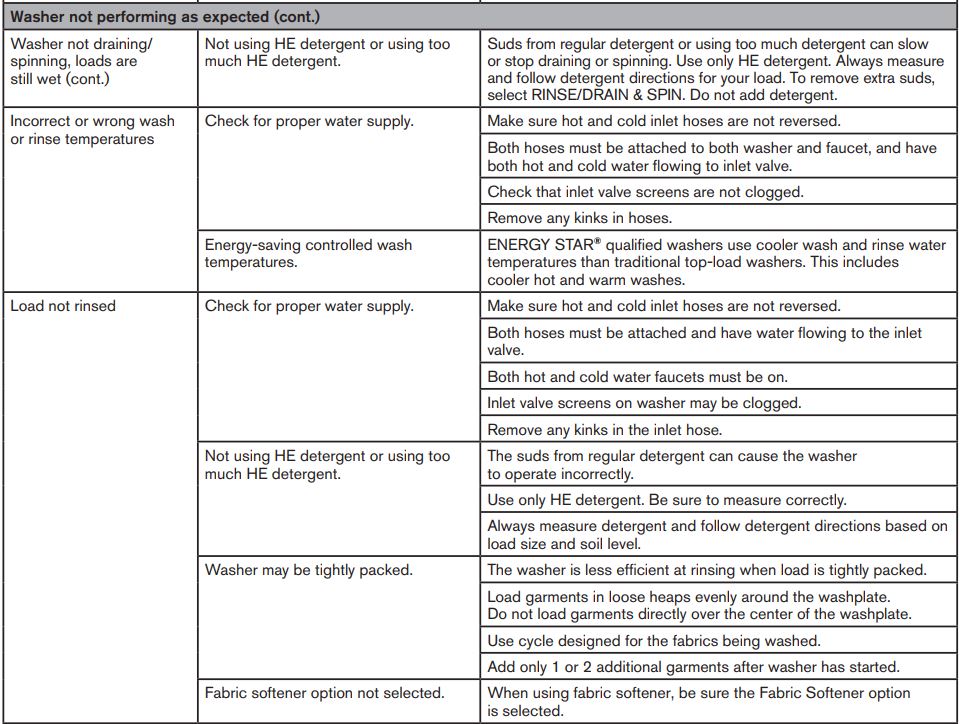





ACCESSORIES
See Installation Instructions for installation accessories

MAYTAG ® LAUNDRY LIMITED WARRANTY
This Maytag Limited Warranty supersedes and replaces the limited warranty printed in the Use and Care Guide for products sold within the United States of America and Canada.
FIRST-YEAR LIMITED WARRANTY (PARTS AND LABOR)
For one year from the date of purchase, when this major appliance is installed, operated, and maintained according to the instructions attached to or furnished with the product, Maytag brand of Whirlpool Corporation or Whirlpool Canada LP (hereafter “Maytag”) will pay for factory specified parts and repair labor to correct defects in materials or workmanship that existed when this major appliance was purchased.
SECOND THROUGH TENTH YEAR LIMITED WARRANTY (DRIVE MOTOR AND WASH BASKET ONLY – LABOR NOT INCLUDED)
In the second through tenth years from the date of original purchase, when this major appliance is installed, operated, and maintained according to instructions attached to or furnished with the product, Maytag will pay for the replacement of the wash basket drive motor and stainless steel wash basket (side walls only) to correct non-cosmetic defects in materials or workmanship in these parts that prevent the function of the washer and that existed when this major appliance was purchased. This limited 10-year warranty on the wash basket drive motor and stainless steel wash basket (side walls only) does not include labor. YOUR SOLE AND EXCLUSIVE REMEDY UNDER THIS LIMITED WARRANTY SHALL BE PRODUCT REPAIR AS PROVIDED HEREIN. Service must be provided by a Maytag-designated service company. This limited warranty is valid only in the United States or Canada and applies only when the major appliance is used in the country in which it was purchased. This limited warranty is effective from the date of the original consumer purchase. Proof of the original purchase date is required to obtain service under this limited warranty.
ITEMS EXCLUDED FROM THE WARRANTY
This limited warranty does not cover:
- Replacement parts or repair labor if this major appliance is used for other than normal, single-family household use or when it is used in a manner that is inconsistent with published user or operator instructions and/or installation instructions.
- Service calls to correct the installation of your major appliance, to instruct you on how to use your major appliance, to replace or repair house fuses, or to correct house wiring or plumbing.
- Service calls to repair or replace appliance light bulbs, air filters, or water filters. Consumable parts are excluded from warranty coverage.
- Damage resulting from accident, alteration, misuse, abuse, fire, flood, acts of God, improper installation, installation not in accordance with electrical or plumbing codes, or use of products not approved by Maytag.
- Cosmetic damage, including scratches, dents, chips, or other damage to the finish of your major appliance, unless such damage results from defects in materials or workmanship and is reported to Maytag within 30 days from the date of purchase.
- Pick up and delivery. This major appliance is intended to be repaired in your home.
- Repairs to parts or systems resulting from unauthorized modifications made to the appliance.
- Expenses for travel and transportation for product service if your major appliance is located in a remote area where service by an authorized Maytag servicer is not available.
- The removal and reinstallation of your major appliance if it is installed in an inaccessible location or is not installed in accordance with Maytag’s published installation instructions.
- Replacement parts or repair labor on major appliances with original model/serial numbers that have been removed, altered, or cannot be easily determined.
DISCLAIMER OF IMPLIED WARRANTIES
IMPLIED WARRANTIES, INCLUDING ANY IMPLIED WARRANTY OF MERCHANTABILITY OR IMPLIED WARRANTY OF FITNESS FOR A PARTICULAR PURPOSE, ARE LIMITED TO ONE YEAR OR THE SHORTEST PERIOD ALLOWED BY LAW. Some states and provinces do not allow limitations on the duration of implied warranties of merchantability or fitness, so this limitation may not apply to you. This warranty gives you specific legal rights, and you also may have other rights that vary from state to state or province to province.
LIMITATION OF REMEDIES; EXCLUSION OF INCIDENTAL AND CONSEQUENTIAL DAMAGES
YOUR SOLE AND EXCLUSIVE REMEDY UNDER THIS LIMITED WARRANTY SHALL BE PRODUCT REPAIR AS PROVIDED HEREIN. MAYTAG SHALL NOT BE LIABLE FOR INCIDENTAL OR CONSEQUENTIAL DAMAGES. Some states and provinces do not allow the exclusion or limitation of incidental or consequential damages, so these limitations and exclusions may not apply to you. This warranty gives you specific legal rights, and you also may have other rights that vary from state to state or province to province.
If outside the 50 United States and Canada, contact your authorized Maytag dealer to determine if another warranty applies. If you think you need repair service, first see the “Troubleshooting” section of the Use & Care Guide. If you are unable to resolve the problem after checking “Troubleshooting,” additional help can be found by checking the “Assistance or Service” section or by calling Maytag. In the U.S.A., call. In Canada, call. 06/10
FAQs Maytag MVWB880BW
What is the Maytag Bravos washer’s lifespan?
A Maytag washing machine lasts 11 years on average. If your appliance is a high-end model, Consumer Reports advises waiting to replace it until it is at least eight years old.
Why won’t a Maytag washer turn on?
Examine the outlet: The power wire for the washer should be correctly plugged in. Unplug the washer and plug in a small electronic item to test the outlet’s functionality. Keep extension cords away: The voltage that the washer needs to operate cannot be consistently transmitted by these cords, which causes power interruptions.
What is a Maytag mvwb880bw0’s capacity?
Size: 4.8 cubic feet
How long does a Maytag washer’s typical cycle last?
The average wash cycle lasts between one and two hours, however, actual wash times depend on the model and cycle option. Before you start washing, check your owner’s manual for information on specific cycles, such as how long it takes your washing machine to finish various wash cycles and usage and maintenance guidelines.
Do Maytag washers have a good build?
Many consumers who purchase their appliances believe that Maytag is a dependable brand. Since it is not a luxury brand, you can purchase a durable washer and dryer for a reasonable price. The majority of its items are created in the United States and include customer service protection and extended warranties.
Is there a reset button on Maytag?
Although Maytag washers lack a reset button, it is possible to reset them by pushing a specific set of buttons together. The easiest approach to attempt is this: first press power or cancel. Choose a new cycle to run next.
What’s wrong with the Maytag washer?
Not spinning or agitating, as well as having trouble draining or filling with water, are some of the common Maytag front-load washer issues. It’s possible that your washing machine makes noises or vibrates during the spin and wash cycles. Don’t tolerate misconduct from appliances of this nature.
How long does a typical Maytag wash require?
For a typical wash cycle, front-load washing machine cycle periods might range from 60 to 80 minutes.
What is the lifespan of a Maytag washer?
Maytag washers typically last ten years with proper care and excellent usage practices. A 10-year limited guarantee is also offered with many models, which can help keep the appliance in peak condition.
What is the Maytag washer’s quickest cycle?
Small, lightly soiled loads can be cleaned in 30 minutes using the Quick Wash cycle.
For more Maytag Manuals visit ManualsDock


